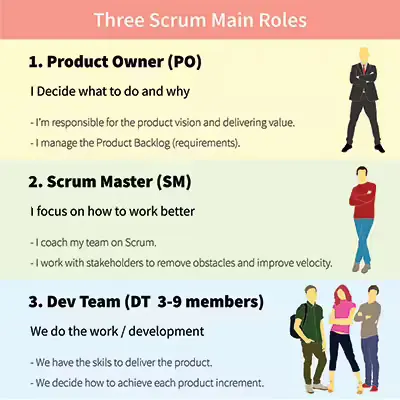
If you work in software development, or maybe even if you don't, you've probably heard the phrase "scrum" used to describe the way teams get things done. If you don't work in software development, you've probably heard it nonetheless. Scrum is a project management style that is utilized in a variety of sectors, but software development is its primary application. The scrum technique is led by a scrum master, who acts as the method's facilitator. The scrum methodology places a premium on the idea that teams should make their own judgments regarding the most effective ways to achieve their objectives, as well as the partitioning of projects into a number of smaller deliverables.
You could possibly be familiar with the concept of agile software development. There is overlap between agile and Scrum, but they are not the same thing. Scrum is one of the most well-known agile frameworks, which may also be thought of as processes for carrying out work in accordance with agile principles.
Therefore, what exactly are the agile principles? The Agile Manifesto was conceived in February of 2001 during a gathering of software engineers who were searching for a more effective method to manage their work without becoming bogged down in convoluted procedures or missing critical deadlines. In the Agile Manifesto, its authors claim that they value the following:
- Humans and interactions in preference to procedures and instruments
- working software over comprehensive documentation customer collaboration over contract negotiation responding to change over following a plan working software over following a plan
- Each phrase is composed of two distinct elements. The left side of each phrase—that is, individuals and interactions—is given greater weight in Scrum principles than the right side—that is, processes and tools. Both of these are essential, but I'd put greater emphasis on the left half. The agile project management methodology has recently seen a surge in popularity, particularly within the technology sector. This can be
- attributed to the fact that it places an emphasis on delivering finished products that consumers are eager to utilize.
It is recommended in the Scrum Guide that teams include no more than 10 people and that there be no subteams. The individuals on the team are accountable for charting their own course toward the objective and completing the work within the allotted timeframe. In order to ensure that the job is completed on time, large projects are broken down into smaller portions, and each of these components has its own deadline.
The sprint serves as the primary unit of measurement for scrum teams. Sprints are periods of time that are no longer than one month and during which the team focuses on accomplishing particular goals. Anything significantly longer than that could cause the sprint's scope to expand. The members of the team focus their efforts on completing the current sprint before turning their attention to the upcoming work.
Individual members of the team gain knowledge through experience. The team takes a retrospective look at its past performance at the conclusion of each phase of the job. Along the process, the team gets together at set intervals to go over progress and make certain that everybody is pulling their weight and that nothing slips behind schedule.
The Team Working in Scrum

Every member of the scrum team makes a contribution toward the successful conclusion of the project. There are two persons who operate as team leads for each sprint: the product owner and the scrum master. All of the members of the team may be developers. The product owner is responsible for ensuring that the scrum team integrates feedback from stakeholders and for managing the product backlog, which is a list of activities that need to be completed within this time period of work.
Dodge common #Scrum pitfalls with this 5-Step Infographic! From understanding your role to promoting team dynamics, to fostering a relationship with the Product Owner - become the #ScrumMaster you aspire to be! #Agile #ProjectManagement pic.twitter.com/f0Ygu6gcsH
— IT Buddha (@pm_itbuddha) May 22, 2023
The role of "product owner" suggests a more conventional approach to management, but what exactly is a "scrum master"? The primary responsibility of the scrum master is to monitor team activities to ensure compliance with predefined procedures. One of the roles of the scrum master is to make certain that all members of the team have an understanding of the scrum process and that the group is working toward the sprint goal. The accomplishment of the team's goal is the responsibility of the team as a whole, not the scrum master; yet, the scrum master may feel a great deal of pressure to ensure that the team is successful in achieving its objective.
Everyone on the scrum team is responsible for planning the sprint, and after the aim of the sprint has been determined, the team is not allowed to make any adjustments that may cause them to miss their deadline. In the event that the development team discovers issues while the process is underway, the team may be required to alter its product backlog as well as the scope of the sprint in order to maintain a realistic view of the deadline.
Daily scrums are short meetings that are held each day for the purpose of teams checking their progress and planning out what has to be done on that particular day. There is no requirement for the product owner or scrum master to participate in the daily scrum unless they are also actively contributing to the development of the product during the sprint. The team gets together for an overall review as the sprint draws closer to its end. After the sprint is finished, the members of the team get together for a retrospective meeting to discuss their performance during the sprint and brainstorm ways in which they may improve for the subsequent sprint.
In order to provide you with a better picture of the atmosphere in which the scrum master operates, we have oversimplified the procedure. They have a lot of work to do to ensure that everything goes according to the plan.
The Multiple Roles Played by the Scrum Master
It is simple to conceive of a scrum master as an elevated version of a project manager; however, there is more to the role than simple task management. They are required to handle a variety of responsibilities for the team in order to follow the scrum process. Barry Overeem, a professional scrum trainer, authored a white paper titled "The 8 Stances of a Scrum Master," in which he discusses the various responsibilities that come with holding the job of scrum master.
A servant leader is someone who puts the needs of the team ahead of their own and works to ensure that the team has everything it needs to complete the task at hand. A coach is someone who helps the team focus on completing a sprint successfully while also assisting individuals outside the team in comprehending how the technique operates.
Related link : What Does It Mean to Live in a Community That Has Been Master-Planned, and Why Is That Important?
The role of the facilitator is to ensure that all members of the team are able to effectively collaborate by ensuring that each person is aware of their own and others' duties.
A teacher who is responsible for instructing the rest of the team on how to efficiently use the scrum process.
mentor - providing the team manager with advice and guidance based on the scrum master's own expertise working with agile methodology – enforcing boundaries between parties, managing the health of the team, and sticking to the scrum process impediment remover – eliminating problems for the developers to keep everything running smoothly impediment remover – enforcing boundaries between parties, managing the health of the team, and sticking to the scrum process impedi
A change agent is someone who is responsible for ensuring that the wider organization has a favorable working environment that is conducive to scrum procedures.
The scrum master is not the head of the team; rather, it is his or her responsibility to manage the process rather than the individuals who make up the team. According to the Scrum Guide, in concept, the teams are "self-managing," which means that they decide among themselves "who does what, when, and how." However, the scrum master may be required to provide training to members of the scrum team on self-management and cross-functionality (skills that are necessary to complete the sprint). In addition to this, the scrum master works to remove any potential roadblocks that may stand in the way of the team's progress.
At the same time, the scrum master assists the product owner by ensuring that the project continues in the intended direction, that the scrum goals are understood by everyone involved, and that the scrum events are organized.
Becoming an Experienced and Qualified Scrum Master
Training is provided by the Scrum Alliance for individuals who are interested in becoming scrum masters as well as certified scrum masters who wish to maintain and improve their technical abilities. You are not required to take the courses offered by the Scrum Alliance in order to get ready; other professionals also offer scrum training. However, in order to get certified by the Scrum Alliance, you will need to demonstrate that you have the necessary knowledge. After you have obtained your scrum certification, you will be expected to continue your scrum education and maintain your certification at regular intervals.
There are three levels of scrum master certification, each representing an increasing level of mastery. To earn each level, you will need to demonstrate not only how much you know, but also how well you can use the scrum technique in increasingly complex scenarios. You will be expected to demonstrate mastery of the following five fundamental scrum competencies:
Learning and using the Scrum framework Developing people and teams Managing projects with agility Developing and delivering products professionally Evolving the Agile Organization Understanding and applying the Scrum methodology
In spite of the fact that scrum was developed to facilitate software development projects, many people have discovered that utilizing it in other contexts, including non-technical settings, can be beneficial. Members of a scrum team may, subject to the circumstances, modify the rules so that they better suit their purposes. Methods such as scrum and agile are used by organizations in many different areas, including the manufacturing of physical products, education, research, and training.

